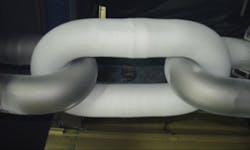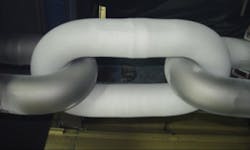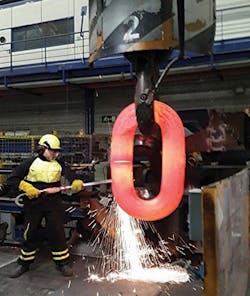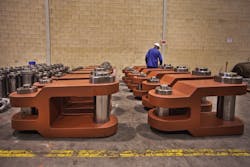Wide-ranging environmental factors impact offshore moorings design
Onintze Matias,Vicinay Marine
Mooring linedesign is critical to the safety of floating steel offshore structures. The requirements for oil and gas platforms and floating offshore wind systems differ widely depending on the application, technology employed, and the geographic location. Each project has its own special characteristics, and the mooring system and its individual components must take account of these factors.
The chains and connectors that comprise the mooring system are more than a standard product and need to be considered as part of a tailor-made solution. Vicinay Marine group has developed an‘Ad hoc mooring philosophy’ which seeks to maximize the integrity and improve the safety of the various components while optimizing the overall system cost.
Thermal Sprayed Aluminum-protected chain link.
Hurricanes in the Gulf of Mexico, warm-temperature areas such as those found offshore West Africa or East Asia, and the harsh Arctic environment all present different challenges to mooring chain integrity. During the system’s design phase, long-term performance factors that need to be considered include fatigue, corrosion, damage induced by hurricane or cyclone conditions, deepwater, the composition of the seabed and local marine life, and the need to reduce operational and maintenance costs during service, particularly in remote, ultra-deepwater settings. Through the Ad Hoc Mooring approach, solutions can be provided to address these challenges and minimize the impact of these degradation mechanisms.
Higher grade, larger diameter
The new R6 grade for chain and connectors with an ultimate tensile strength of 1,100 MPa provides increased strength which offers a larger safety margin and enhanced security in challenging metocean conditions and ultra-deepwaters. The weight reduction gained by moving to a higher grade contributes to a decreased payload of the vessel or platform and leads to easier handling and installation. Research on the fatigue performance and fracture mechanics of R6 demonstrates this grade is a significant solution for the offshore industry, with weight reduction an increasing preoccupation for operators of many projects. At the same time, the need to extend design life and introduce larger corrosion allowances means that sometimes bigger is better with regards to chain diameter. The ability to supply 220-mm diameter chain in all grades, certified by all major classification societies, is a positive development in this regard.
220-mm diameter chain link manufacturing.
(All images courtesy Vicinay Marine)
Corrosion is a concern especially for moorings in warm-temperature regions, and mainly at the splash zone where there is high oxygen content. The impact of bacterial corrosion should be considered as well, not solely on the seafloor but in different positions along the mooring lines. Several coatings have been developed to prevent or to minimize general corrosion, such as Thermal Sprayed Aluminum (TSA), or others to protect components against wear and abrasion, such as Thermal Sprayed Carbide (TSC). Both coatings have been proven in laboratory tests and a real offshore environment. Alternative coating solutions are also under development with a focus on impact protection and bacterial corrosion.
Interface points of mooring lines are critical and must be analyzed in detail to ensure the connector design is optimized to suit the required function. Numerous special accessories can be designed, manufactured, and delivered to facilitate installation and operation including ROV-operable connectors, dedicated installation links, and all types of D-type connectors and H-links.
In addition to optimized accessories, chain link geometry can be modified. By changing the geometry and therefore the weight of the links, variable geometry and weight (VGW) products are an option. VGW chain can reduce overall mooring line tonnage, increase resistance to corrosion, improve fatigue life characteristics, and enhance the line’s response to tension.
H-link design connectors.
Harsh environments subject to unexpected occurrences also need special care in product design. The Arctic region, for example, combines very low temperatures with an ice impact risk. For mooring systems in these settings, specific heat treatments that assure proper mechanical properties during the service life can provide a means of increasing the structural integrity.
The Ad hoc mooring philosophy will continue to gain knowledge of how mooring lines perform and develop optimized products that function properly in a specific environment. •



